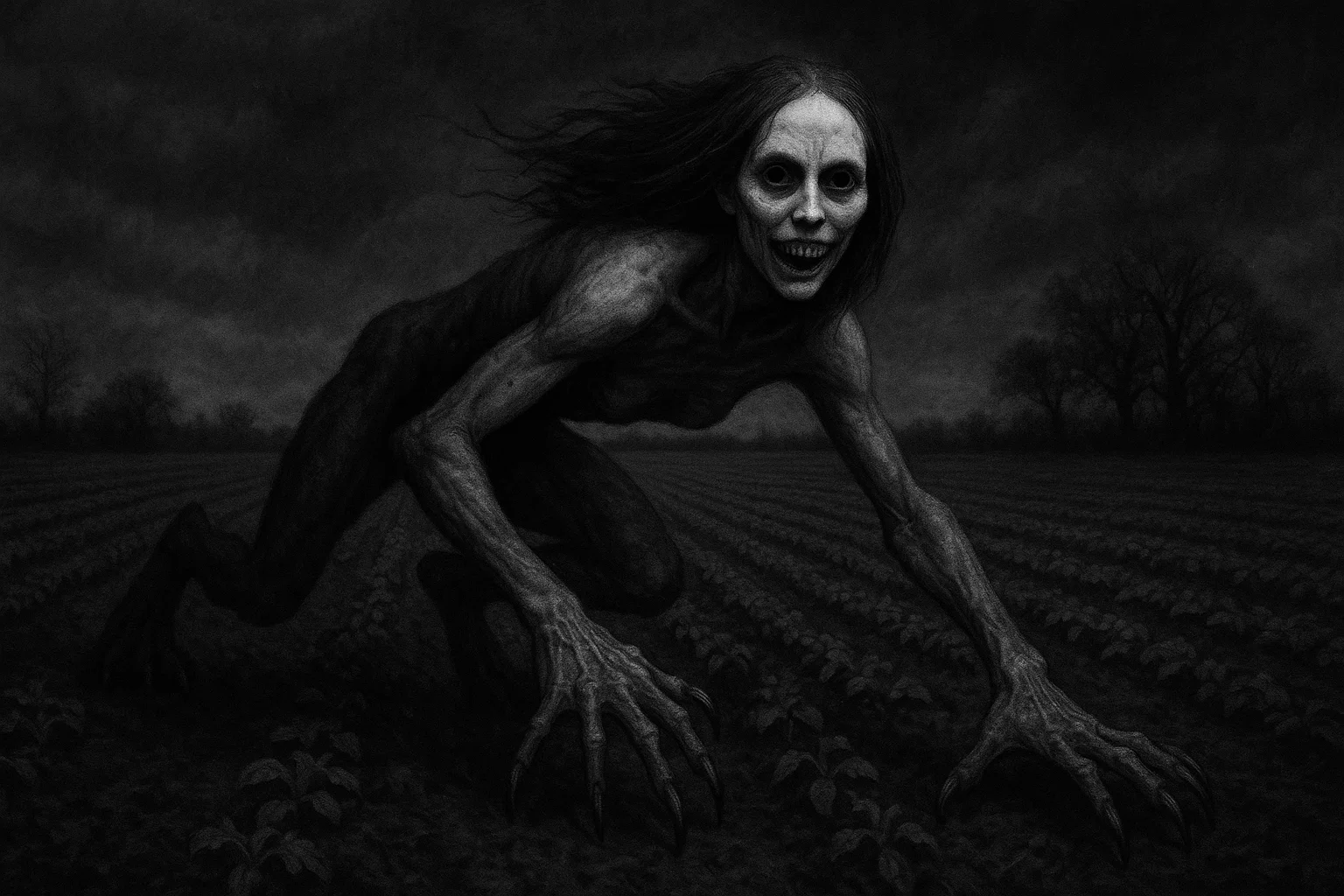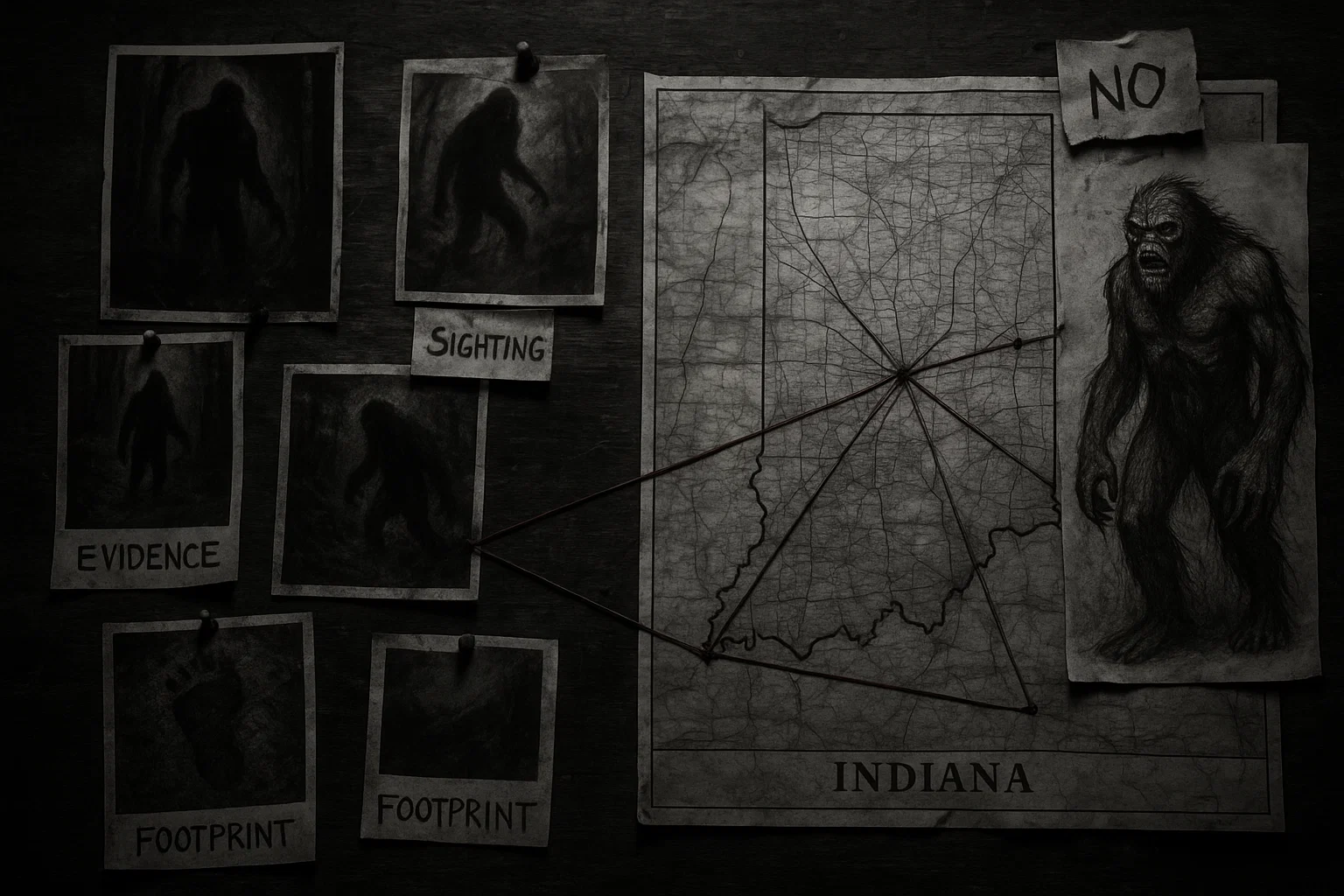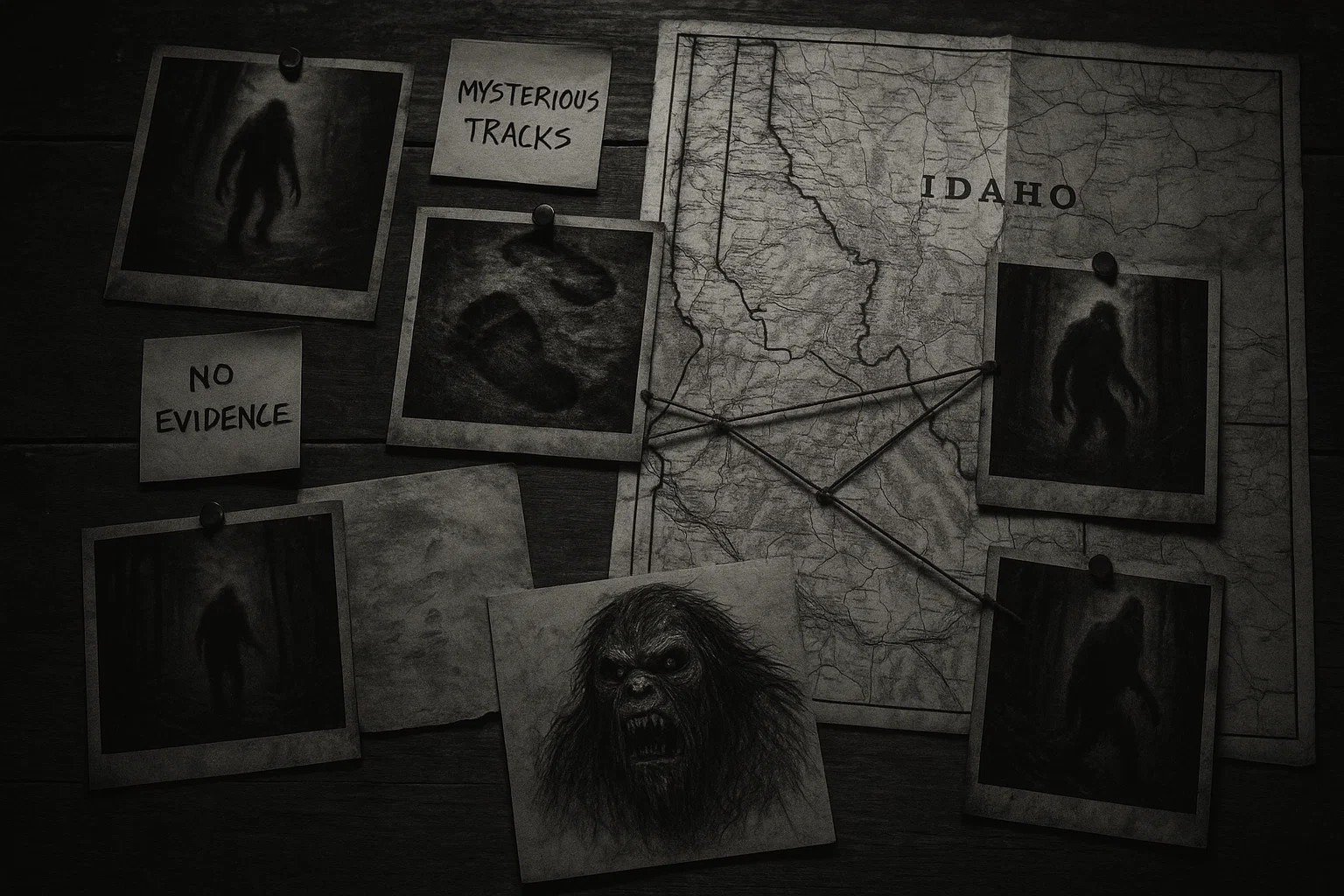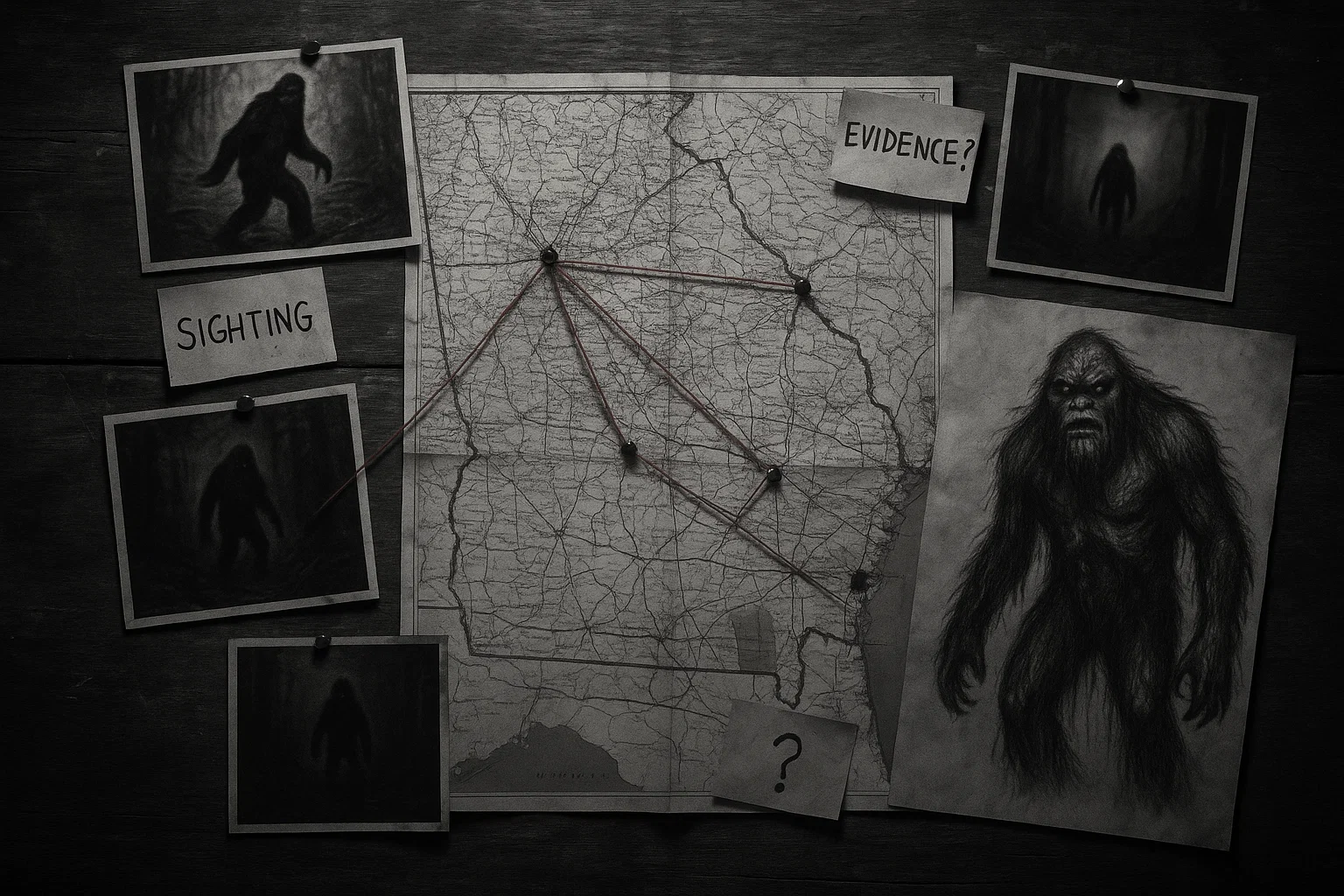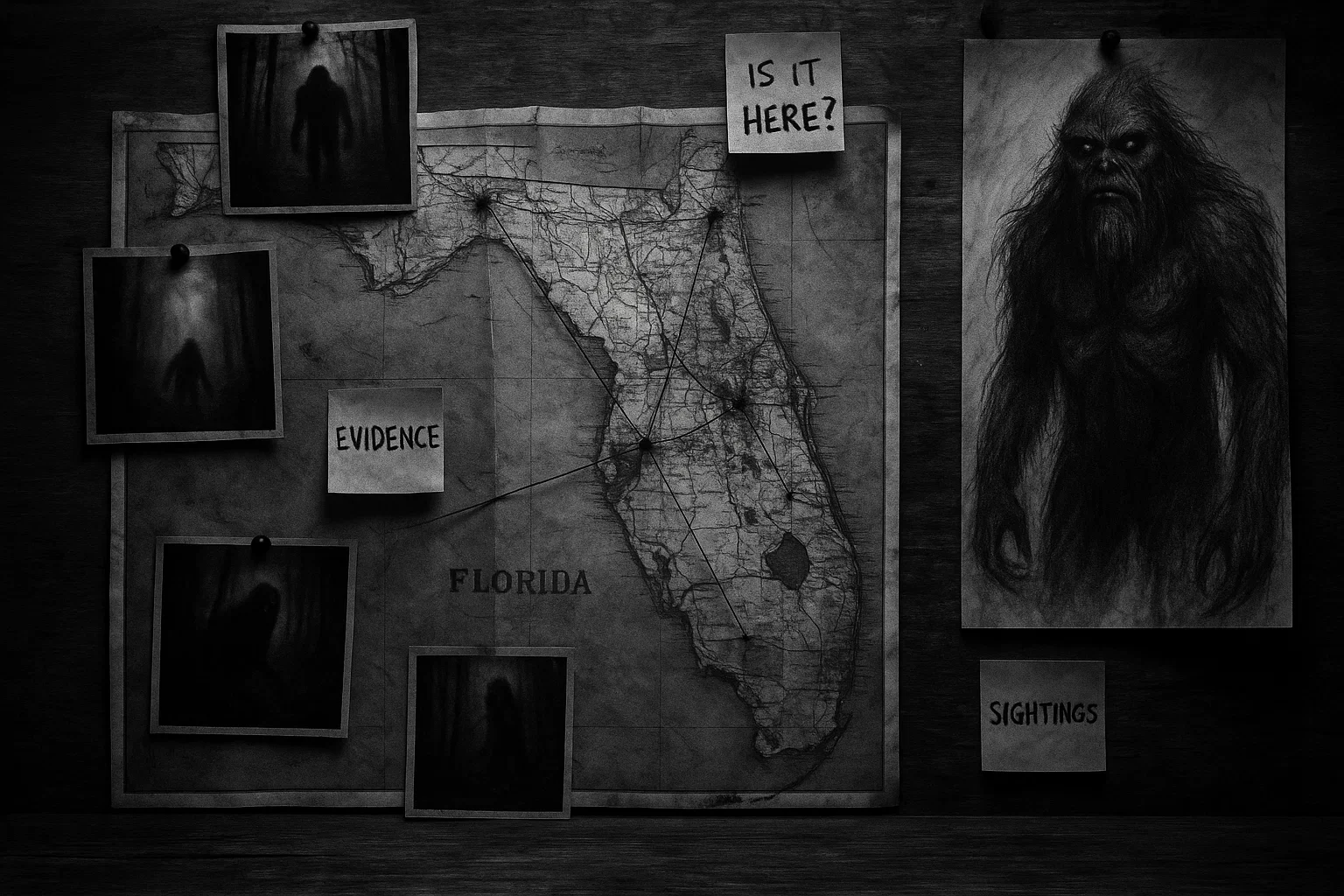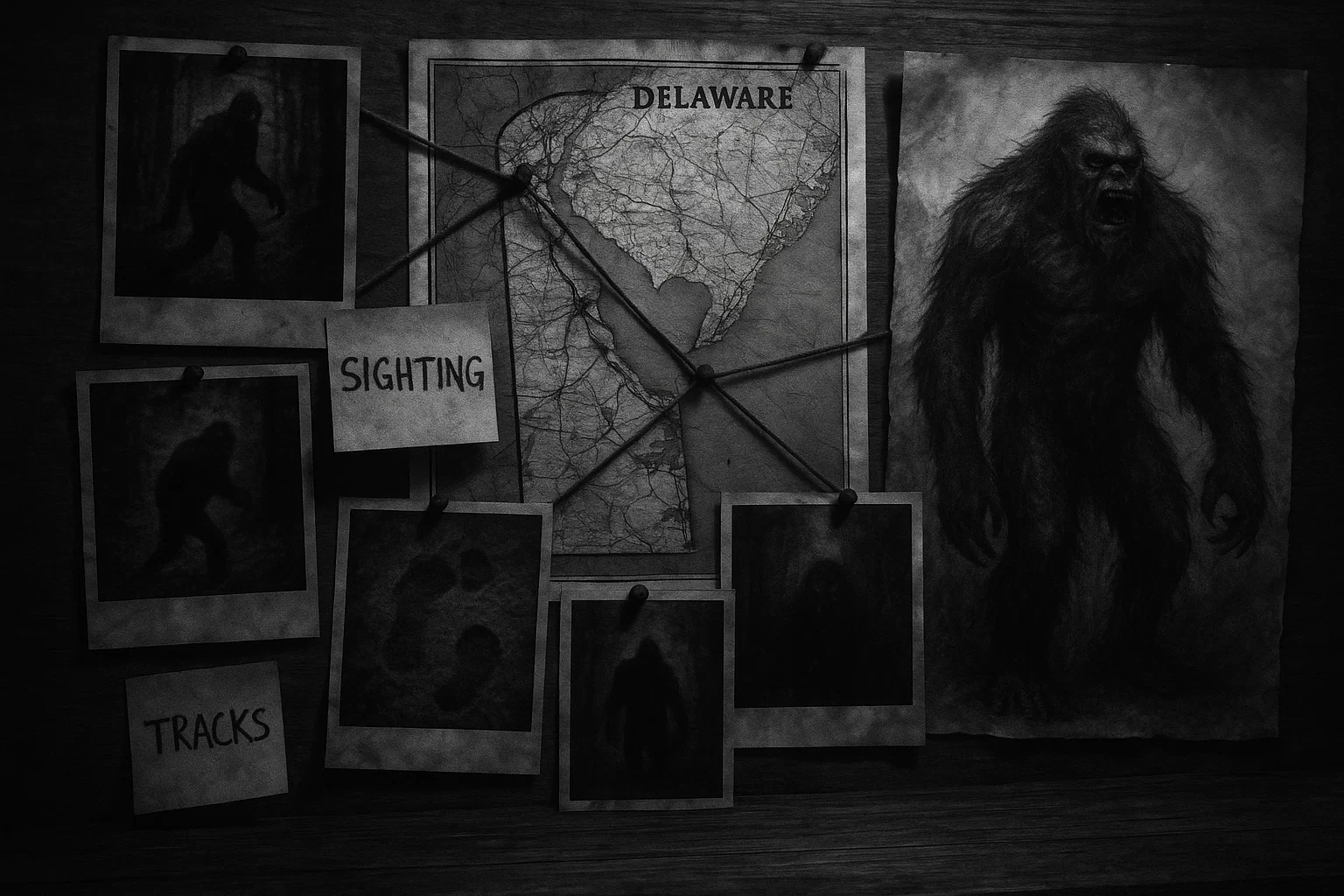Picture a quiet evening in Chunchula, Alabama, a rural hamlet just north of Mobile. The pine forests hum with cicadas, and the air hangs heavy with humidity.
Suddenly, a chilling howl breaks the silence, and a shadowy figure—half-woman, half-wolf—emerges from the woods, its glowing eyes locking onto you!
This is the Chunchula Wolf Woman, a cryptid that has haunted this small community since the 1970s. Strikingly similar to the Wolf Woman of Mobile, it raises questions: are they the same creature, or distinct denizens of Alabama’s wilds?
For example, both share wolfish features and elusive behaviors, yet subtle differences complicate the picture.
Let’s delve into its forested habitat, terrifying appearance, mysterious behavior, detailed sightings, media coverage, possible identities, and comparisons to other cryptids—particularly the Mobile Wolf Woman—while exploring Chunchula’s eerie history.
Table of Contents
Habitat
The Chunchula Wolf Woman roams Chunchula, a rural community in Mobile County, Alabama, approximately 20 miles north of Mobile’s downtown.
Covering roughly 15 square miles, Chunchula is a sparsely populated area (1,506 residents in 2020) characterized by dense pine forests, oak groves, and scattered swamps fed by tributaries of the Mobile-Tensaw Delta, located 15 miles south.
Sightings often occur along Highway 45, a two-lane road cutting through thick woods, or near Celeste Road, a winding path flanked by creeks and marshes.
For instance, the Escatawpa River, 5 miles west, and Gulf Creek, a local waterway, create boggy, secluded areas ideal for a secretive creature. These habitats mirror the swampy haunts of the Wolf Woman of Mobile, suggesting a shared preference for wet, forested cover.
Chunchula’s history is steeped in rural simplicity and strange tales. Originally a timber and farming hub settled in the 1800s, it derives its name from a Choctaw word meaning “to howl,” fittingly ironic given the cryptid’s vocalizations (Mobile County Historical Society, 1980).
The Choctaw, native to the region until their 1830s removal, told of Kashota, a shapeshifting wolf spirit, which may underpin local cryptid lore. In 1847, the Mobile Register reported a “ghostly beast” near Gulf Creek, described as a “howling shadow” that spooked horses. During the 1920s, loggers claimed to see “glowing eyes” in the woods, per oral histories collected by the University of South Alabama.
By the 1970s, Chunchula’s isolation—lacking Mobile’s urban sprawl—made it a hotspot for cryptid tales, amplified by the era’s fascination with Bigfoot and werewolves. Indeed, the Chunchula Baptist Church, a 1901 landmark, hosts storytelling events where locals share Wolf Woman tales, keeping the legend alive.
Thus, Chunchula’s wild terrain and haunted past create a perfect stage for this Alabama cryptid.
What Does the Chunchula Wolf Woman Look Like?
What does the Chunchula Wolf Woman look like? Witnesses describe a formidable figure standing 5.5 to 6.5 feet tall, slightly shorter than the Wolf Woman of Mobile’s 6–7 feet.
Its body is covered in dark brown or gray fur, often described as patchy or matted, suggesting frequent treks through wet marshes. The limbs are lean yet muscular, ending in clawed hands—“long, sharp nails like knives,” per a 1976 witness (Mobile Press-Register, April 10, 1976).
The face blends human and wolf traits: most accounts, like a 1990 sighting, note a wolf-like snout with pointed ears and glowing yellow eyes, but a 2007 report described “a woman’s face, pale and eerie” (WKRG-TV, June 15, 2007). This human-wolf hybrid face closely resembles Mobile’s cryptid, though Chunchula’s is often leaner.
The glowing eyes—yellow, occasionally orange—are a hallmark, shining “like lanterns” in the dark, according to a 1982 account. Unlike Mobile’s Wolf Woman, a tail is rarely mentioned; only one 1976 report noted a “short, stubby” one.
You May Also Like: Mackenzie Poltergeist: World’s Most Violent Haunting?
The creature’s fur emits a faint, musky odor, less pronounced than Mobile’s “wet dog” stench. Tracks, when reported, measure 9–10 inches with claw marks, slightly smaller than Mobile’s 10-inch prints.
For example, a 1990 sighting included tracks “deep in the mud, like a heavy dog’s but longer” (Mobile Register, September 20, 1990). In brief, the Chunchula Wolf Woman is a leaner, wolfish humanoid, strikingly similar to its Mobile counterpart yet distinct in stature and tail rarity.
Behavior
The Chunchula Wolf Woman’s behavior is elusive, mirroring the Wolf Woman of Mobile but with nuanced differences. Primarily nocturnal, it emerges at dusk to roam forests and creeks.
It moves swiftly—“like a shadow, faster than a man,” per a 1990 witness—though less agile than Mobile’s 30-mile-per-hour sprinter (Mobile Register, September 20, 1990). For instance, it darted across Highway 45 in 1976, vanishing before pursuit.
Conversely, it’s stealthy, often watching from a distance, as a 2007 hunter learned when it observed him silently (WKRG-TV, June 15, 2007). A high-pitched howl, “like a woman screaming,” is its signature, distinct from Mobile’s deeper “half-human” cry, reported in 1976 and 1990.
Surprisingly, it avoids human contact; no attacks are documented.
Instead, it startles—staring with glowing eyes or fleeing when spotted. In the 1970s, farmers near Celeste Road blamed it for missing chickens, but no evidence confirmed this, per Mobile County Sheriff’s logs (1976).
Occasionally, it leaves claw marks or tracks, as in 1990, but no odors are consistently noted, unlike Mobile’s musky scent. Notably, it stays within Chunchula’s woods, rarely venturing toward Mobile’s swamps, suggesting a localized territory.
Thus, the Chunchula Wolf Woman is a shy, vocal phantom, closely aligned with Mobile’s cryptid but less bold and odoriferous.
Chunchula Wolf Woman Sightings
The Chunchula Wolf Woman’s legend hinges on several sightings from the 1970s to 2000s, each detailed below to cover all witness reports:
April 8, 1976: Truck Driver’s Highway Encounter
At 10:00 p.m., Carl Jenkins (34), a truck driver, was driving along Highway 45, 2 miles north of Chunchula’s post office. Near Gulf Creek, his headlights caught a 6-foot, brown-furred figure crossing the road. “It had a wolf’s face, yellow eyes, and a stubby tail—stood like a woman,” he told the Mobile Press-Register (April 10, 1976).
You May Also Like: Asmodeus: The Demon King of Lust and Forbidden Knowledge
The creature froze, howled “like a scream,” and darted into the pines. Jenkins stopped but found no tracks due to gravel. Sheriff’s deputy Roy Tate dismissed it as a dog, but Jenkins insisted, “It wasn’t no hound!” The story spread at Chunchula’s general store, prompting locals to avoid Highway 45 at night.
September 18, 1990: Teenagers’ Campsite Sighting
At 9:30 p.m., three teenagers—Bobby Lee (17), Karen Holt (16), and Mike Webb (18)—were camping near Celeste Road, 3 miles west of Chunchula.
A howl woke them; 40 yards away stood a 6.5-foot, gray-furred figure with yellow eyes. “It looked wolfish but walked upright, like a lady,” Holt told the Mobile Register (September 20, 1990). It watched for 5 minutes, then fled. The teens found 9-inch claw-marked tracks in the mud, photographed by deputy Sarah Mills, who blamed a coyote.
WPMI-TV aired a segment on September 21, drawing 10 calls about similar sightings. The teens avoided camping thereafter, shaken by the “screaming howl.”
June 13, 2007: Hunter’s Forest Encounter
At 6:00 a.m., David Pratt (45), a construction worker and hunter, was tracking deer off Lott Road, 4 miles south of Chunchula. Near a creek, he saw a 5.5-foot, brown-furred figure with orange eyes and a “woman’s face, pale and wolf-like,” he told WKRG-TV (June 15, 2007).
It howled softly and ran, leaving no tracks on dry ground. Pratt fired his shotgun, missing. Deputies found claw marks on a tree but no prints. Sheriff Sam Cochran suggested a bobcat, but Pratt countered, “Bobcats don’t stand like that!”
The sighting revived local interest, discussed at Chunchula Baptist Church gatherings.
August 22, 2014: Farmer’s Field Sighting
At 8:00 p.m., Ellen Travis (52), a farmer, saw a 6-foot, gray-furred figure near her barn off Highway 45, 1 mile from Chunchula’s center. “It had wolf ears, yellow eyes, and walked upright—no tail,” she posted on Bigfoot Believers (Facebook, August 23, 2014). It howled and fled into the woods.
Travis found 10-inch tracks but no claw marks. Mobile County police dismissed it as a dog, but neighbors reported two similar sightings that month. The report gained traction on Reddit’s r/Cryptids, with users linking it to 1976 accounts, though no major media covered it.
Media Coverage
The Chunchula Wolf Woman’s media presence is less prominent than the Wolf Woman of Mobile’s but endures locally. The Mobile Press-Register’s April 10, 1976, article quoted Carl Jenkins and noted “several” unverified reports, sparking community buzz.
The Mobile Register’s September 20, 1990, piece on the teenagers’ sighting included track photos, with reporter Jane Lee suggesting a Choctaw Kashota connection.
WKRG-TV’s June 15, 2007, broadcast featured David Pratt’s account, showing tree claw marks and calling it “Chunchula’s mystery.”
Online, Reddit’s r/Cryptids (2023) and Bigfoot Believers (Facebook) discuss the 2014 sighting, with user “BamaBeast” sharing 1990 clippings and claiming “Chunchula’s got a werewolf.”
The 2018 documentary Cryptic Expeditions: Alabama’s Monsters (IMDb 7.3) mentions it briefly, linking it to Mobile’s Wolf Woman. Additionally, Chunchula’s storytelling events, like those at the Baptist Church, keep the tale alive, though it lacks Mobile’s Mardi Gras flair.
Consequently, the legend persists through local media and oral tradition.
Local Rumor of a “Cursed Woman” in Chunchula
A 2005 blog post on Gulf Coast Mysteries (defunct, archived via Wayback Machine) referenced a Chunchula legend about a “cursed woman” who became wolf-like after a 19th-century witchcraft accusation. Shared at a local diner, the tale claims she haunts Gulf Creek, but no specific sightings are cited.
You May Also Like: Lizard Man of Lee County Cryptid: Sightings, Tracks, and Legends
The story is apocryphal, lacking connection to the 1976–2014 sightings. The article mentions Choctaw shapeshifter lore and 1847 “ghostly beast” reports, covering similar folklore.
What Could It Be? Realistic Explanations for the Chunchula Wolf Woman
The Chunchula Wolf Woman—a 5.5–6.5-foot, furry, bipedal creature with glowing eyes and a piercing howl—has puzzled witnesses since the 1970s.
Below are five realistic theories explaining what it could be, based on its appearance, behavior, and Chunchula’s environment:
1) Misidentified Black Bear
A black bear (Ursus americanus), common in Alabama, mistaken for a humanoid creature due to its size and ability to stand upright.
Why It Fits: Black bears, with populations of 300–400 in Mobile County (Alabama DNR, 2025), can reach 6 feet when standing and have dark brown or grayish fur, matching the cryptid’s color. Their reflective eyes glow yellow/orange under light, as reported in 1976 and 1990 sightings (Mobile Press-Register, April 10, 1976; Mobile Register, September 20, 1990). Bears move swiftly (up to 30 mph) and emit vocalizations, including high-pitched screams, which could be mistaken for a “screaming howl” (2007 sighting, WKRG-TV, June 15, 2007). Standing bears in dim light, especially in Chunchula’s pine forests, might appear bipedal and humanoid, as in the 2014 sighting near a barn (Bigfoot Believers, August 23, 2014).
Why Not: Bears lack human-like faces; witnesses consistently describe a “woman’s face” or wolf-like snout (1990, 2007). Tracks (9–10 inches with claw marks) don’t match bear paws, which are wider and lack elongated claws. Bears are less elusive, often scavenging near humans, unlike the cryptid’s fleeting behavior. No bear attacks align with sightings, despite occasional livestock predation in Chunchula.
Odds: High. Bears are common, and low-light misidentification is plausible, though facial descriptions and tracks reduce likelihood.
2) Costumed Prankster
A person in a wolf-like costume or fur suit staging sightings to scare locals or gain attention, possibly inspired by 1970s cryptid mania.
Why It Fits: The 1970s saw a surge in cryptid hoaxes nationwide, including fake Bigfoot tracks (BFRO, 1975). A costumed individual could mimic a 5.5–6.5-foot figure with fur and glowing eyes (using reflective lenses or lights), as seen in the 1976 Highway 45 sighting (Mobile Press-Register). The high-pitched howl could be human-made, and the lack of attacks aligns with a prankster avoiding harm. Chunchula’s small, tight-knit community (1,506 residents, 2020) makes it an ideal setting for local pranks, as gossip spread quickly (e.g., 1990 campsite sighting, Mobile Register). The 2014 sighting near a barn suggests a figure close to human property, consistent with a prank.
Why Not: Creating 9–10-inch tracks with claw marks, as found in 1990, requires significant effort and skill. Witnesses’ genuine fear—Jenkins avoiding Highway 45 (1976), teens’ trauma (1990)—suggests a convincing act beyond typical pranks. No confessions or evidence of costumes surfaced, unlike some Mobile hoaxes (e.g., 1971 Wolf Woman skepticism, al.com, October 20, 2015).
Odds: High. Pranks are common in rural areas, but physical evidence and witness reactions lower the likelihood slightly.
3) Feral Dog or Wolf-Hybrid
A large feral dog or illegal wolf-dog hybrid, possibly abandoned, roaming Chunchula’s forests and mistaken for a cryptid.
Why It Fits: Feral dogs are prevalent in rural Alabama, with Mobile County reporting 200–300 strays annually (Mobile County Animal Control, 2025). Wolf-hybrids, bred as pets in the 1970s, can reach 5–6 feet when rearing and have gray/brown fur, aligning with the cryptid’s look. Their eyes reflect yellow/orange, and they produce high-pitched howls, as noted in 1976 and 2007 (WKRG-TV). Hybrids move swiftly and avoid humans, matching the cryptid’s elusiveness (e.g., 1990 sighting). Tracks (9–10 inches) could be exaggerated dog prints in soft mud. Chunchula’s proximity to Mobile’s port, a 1970s hub for exotic animals, supports the possibility of an escaped hybrid (Mobile Press-Register, 1974).
Why Not: Wolf-hybrids rarely exceed 4 feet tall and lack human-like faces, contradicting 1990 and 2007 descriptions. Their tracks are smaller (4–6 inches) and paw-like, not claw-marked. Hybrids are aggressive when cornered, yet the cryptid never attacked, even when shot at (2007). No records confirm wolf-hybrid escapes in Chunchula.
Odds: Moderate. A large dog or hybrid is plausible, but facial and track discrepancies reduce the likelihood.
4) A person with Mental Health Issues or Reclusive Lifestyle
A reclusive or mentally ill individual living in Chunchula’s woods, possibly disheveled or wearing furs, mistaken for a creature due to erratic behavior.
Why It Fits: Chunchula’s isolation (15 square miles, sparse population) could conceal a hermit, as suggested in Mobile’s 1971 Wolf Woman debates (Reddit r/UnresolvedMysteries, 2018). A person in furs or ragged clothing might appear furry and wolf-like in dim light, especially with matted hair resembling a “woman’s face” (2007, WKRG-TV). Vocalizations could be human screams, misinterpreted as howls (1990). The cryptid’s non-aggressive behavior and human-like posture (1976, 2014) align with a person avoiding contact. Rural Alabama’s history of neglect cases supports this, as noted in cryptid discussions (Reddit r/Alabama, 2022).
Why Not: A human can’t produce 9–10-inch tracks with claw marks or move with the reported speed (1976, 1990). Glowing eyes require artificial aids, unlikely for a recluse. No missing-person records or local reports (Mobile County Sheriff, 1970s–2010s) match a feral woman in Chunchula. Witnesses describe a distinctly non-human figure.
Odds: Low. Possible but strained by physical evidence and lack of corroborating records.
5) Optical Illusion from Environmental Factors
A combination of low light, fog, and Chunchula’s dense forests creates an optical illusion, misinterpreting animals or shadows as a humanoid creature.
Why It Fits: Chunchula’s pine forests and creeks, especially along Highway 45 and Celeste Road, are foggy at dusk, when sightings occur (1976, 1990, 2014). Fog and headlights can distort shapes, making a coyote (3 feet tall, gray fur) or deer appear larger and bipedal, as in the 1976 Highway 45 sighting (Mobile Press-Register). Animal eyes (coyotes, owls) glow yellow/orange, matching reports. A screech owl’s high-pitched call, common in Mobile County, could be mistaken for a “screaming howl” (2007, WKRG-TV). The lack of attacks and fleeting glimpses (1990, 2014) suggest misperception rather than a real entity.
Why Not: Tracks and claw marks (1990, 2007) indicate a physical presence, not an illusion. Witnesses describe specific details (woman’s face, fur) across decades, less likely from random distortions. Multiple sightings (up to four) reduce the odds of consistent misinterpretation.
Odds: Moderate. Environmental factors explain some traits, but physical evidence and detailed accounts weaken this theory.
Are the Chunchula and Mobile Wolf Women the Same Cryptid?
The Chunchula Wolf Woman and Wolf Woman of Mobile share striking similarities, but differences suggest they may be distinct:
Similarities:
- Appearance: Both are 5.5–7 feet tall, furry (gray/brown vs. gray/black), with glowing eyes (yellow/orange vs. yellow/red) and wolf-human faces. Tracks are 9–10 inches with claws.
- Behavior: Both are nocturnal, elusive, howl, and startle without attacking. They inhabit similar ecosystems (forests vs. swamps).
- Sightings: Both emerged in the 1970s, with reports in Mobile County, 20 miles apart. Choctaw Kashota myths underpin both.
- Cultural Context: Both are tied to Mobile folklore, media (Mobile Register), and online discussions (Reddit, Facebook).
Differences:
- Size and Build: Chunchula’s is leaner (5.5–6.5 feet) vs. Mobile’s bulkier (6–7 feet). Chunchula rarely has a tail; Mobile often does.
- Behavior: Chunchula’s howl is higher-pitched (“screaming” vs. “half-human”). It’s less bold, never chasing cars like Mobile’s 1971 sprint.
- Habitat: Chunchula sticks to pine forests and creeks; Mobile prefers swamps (Dog River, Bayou La Batre).
- Evidence: Chunchula’s odor is faint or absent; Mobile’s is strong. Chunchula’s tracks are slightly smaller (9–10” vs. 10”).
They may be the same cryptid, with differences due to witness perception or regional variation. The 20-mile proximity and shared Choctaw roots support this.
You May Also Like: The Edge of Nothing | Horror Story
However, distinct habitats (forests vs. swamps) and behavioral nuances (howl pitch, boldness) suggest separate entities or localized manifestations. Without physical evidence (DNA, fur), it’s inconclusive, but they’re likely related, possibly the same species or myth.
Comparisons to Other Cryptids
The Chunchula Wolf Woman aligns with other werewolf-like cryptids, particularly the Wolf Woman of Mobile:
| Cryptid | Location | Height | Appearance | Habitat | Key Sightings |
|---|---|---|---|---|---|
| Chunchula Wolf Woman | Chunchula, AL | 5.5–6.5 ft | Brown/gray fur, wolf or human face, yellow/orange eyes, clawed hands, rare tail | Pine forests, creeks (Gulf Creek) | 1976 (truck driver), 1990 (teens), 2007 (hunter), 2014 (farmer) |
| Wolf Woman of Mobile | Mobile, AL | 6–7 ft | Gray/black fur, wolf or human face, yellow/red eyes, clawed hands, often tailed | Swamps, bayous (Mobile-Tensaw Delta) | 1971 (teens), 1985 (hunter), 1992 (family), 2003 (fisherman), 2015 (hiker) |
| Beast of Bray Road | Elkhorn, WI | 6–7 ft | Gray-brown fur, wolf-like head, bipedal, glowing eyes | Rural roads, farmlands | 1989 (Lori Endrizzi, car chase), 1990s (drivers), 2006 (hunter) |
| Rougarou | Southern LA | 7–8 ft | Wolf-reptile hybrid, red eyes, scaly/furry | Bayous (Atchafalaya Basin) | 1800s (Cajun tales), 1970s (farmers), 2010 (fisherman) |
| Skunk Ape | Florida Everglades | 6–8 ft | Brown fur, ape-like face, glowing eyes, foul odor | Swamps, mangroves | 1960s (hunters), 2000 (anonymous photo), 2018 (hikers) |
| Fouke Monster | Fouke, AR | 7–8 ft | Brown fur, ape-like, red eyes, broad build | Swamps (Sulphur River) | 1971 (Ford family attack), 1972 (Boggy Creek film), 1990s (hunters) |
| Ozark Howler | Ozarks (AR, MO) | 5–6 ft | Black fur, bear-wolf hybrid, glowing eyes, horns | Forests, hills | 1800s (settlers), 1990s (farmers), 2010 (hikers) |
Conclusion
The Chunchula Wolf Woman remains a haunting enigma, Alabama’s lesser-known but equally chilling cryptid! From Carl Jenkins’ 1976 encounter to Ellen Travis’ 2014 sighting, its fleeting appearances spark intrigue: is it a coyote, a Kashota spirit, or the same creature as Mobile’s Wolf Woman?
Chunchula’s pine forests, steeped in Choctaw myths and ghostly tales, nurture the legend, sustained by Mobile Register reports and local storytelling.
Closely tied to its Mobile counterpart—sharing fur, howls, and elusiveness—it may be the same entity, though distinct habitats and behaviors suggest otherwise. Whether a prank, mutation, or something supernatural, the Chunchula Wolf Woman’s howl echoes, inviting us to explore Alabama’s wild mysteries.
Next time you’re near Highway 45, listen carefully—something may be lurking!

